

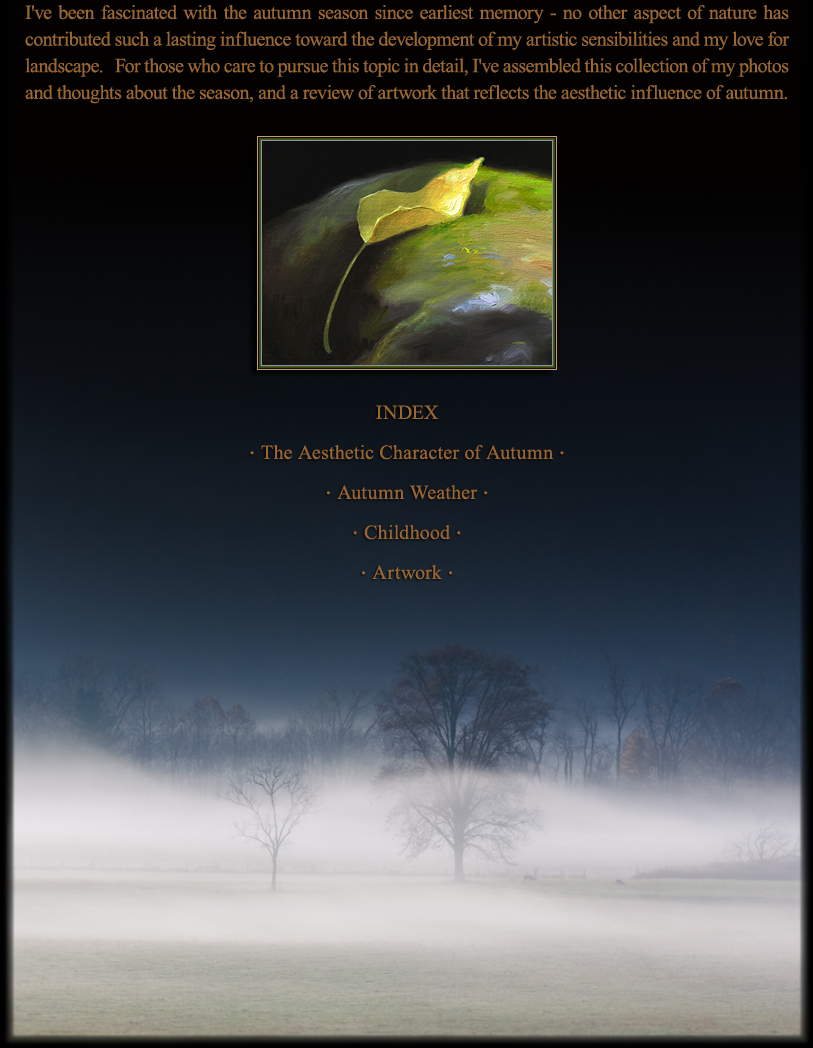
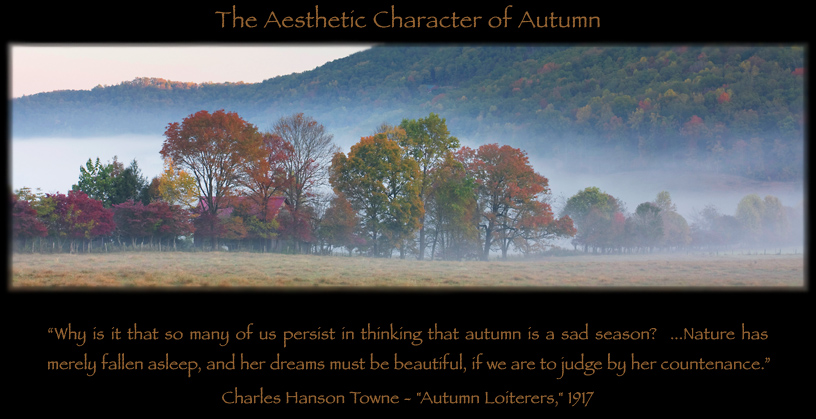
Every season has its own distinctive charm, but autumn has always stood apart for me as an especially compelling time of year because of its dualistic nature: while much anticipated for its exceptional beauty, autumn also foreshadows the prospect of winter's impending hardship, and therefore elicits a mixture of emotional responses more complex and conflicting than those suggested by other seasons. These conflicted feelings seem remarkably well balanced during autumn, rendering the season nearly perfectly bittersweet.
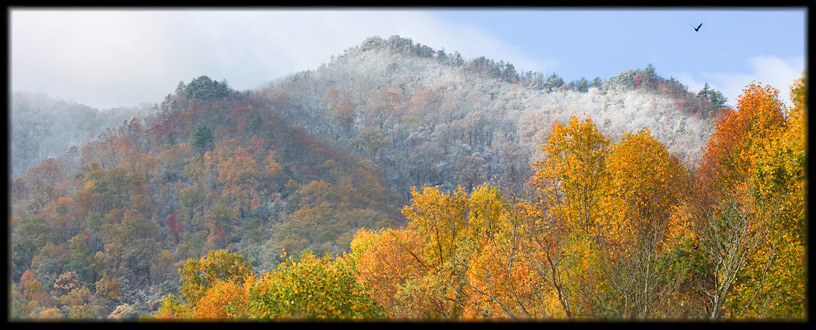
This characteristic defines the special magic of autumn - by achieving a harmony between very different emotional qualities, the season reflects the equally dualistic nature of the whole experience of life, which is at once both wonderful and tragic. In this regard, autumn can be appreciated for its ability to represent the full spectrum of universal circumstances, conveying an abstract truth about a reality larger than the season itself. Through its strange interweaving of positive and negative threads, accomplished in the midst of such a profound transformation of nature, autumn carries an undercurrent of mystery and miraculous potential - an enchanted quality recalling the surreal storytelling landscapes of myth, legend, folklore and fairy-tale, which commonly revolve around similar themes of transformation and duality.
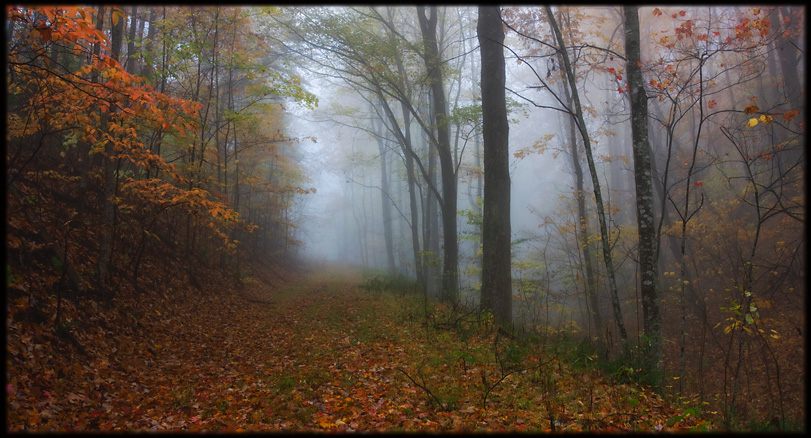
These works of legend and lore also tend to be populated with monstrous or supernatural beings, and autumn's dualistic constitution has always offered a darker dimension of its own character to accommodate these symbols of nature's menacing or mysterious aspects. Ghost stories and similar frights have been traditionally connected with autumn even in the distant past, and while it may at first seem reasonable to assume that the influence of Halloween is responsible for this fact, I think that the reverse is more likely true: that Halloween occurs at this time of year because the season naturally evokes the themes that define the holiday - the apparent demise of nature as it declines toward winter is conducive to personal reflections on one's own mortality, such that ghostly or mystical themes are more readily called to mind.

As an example, Washington Irving's 1820 classic "The Legend of Sleepy Hollow" was written long before Halloween was observed as a holiday in America, yet remains the most recognizable example of a haunted tale strongly associated with autumn. The story manages to seamlessly weave both humor and horror, delivering a result which, like autumn itself, is neither too grim nor too sweet. Despite his interest in ghost stories and superstitions, Irving's tales remain bright and charming because he regards his subjects with such a good-natured smile; this essential cheerfulness maintains an emotional balance that sets Sleepy Hollow apart from other varieties of horror fiction. As a result, an autumnal setting fits the story perfectly, and the story has likewise become virtually emblematic of the season.
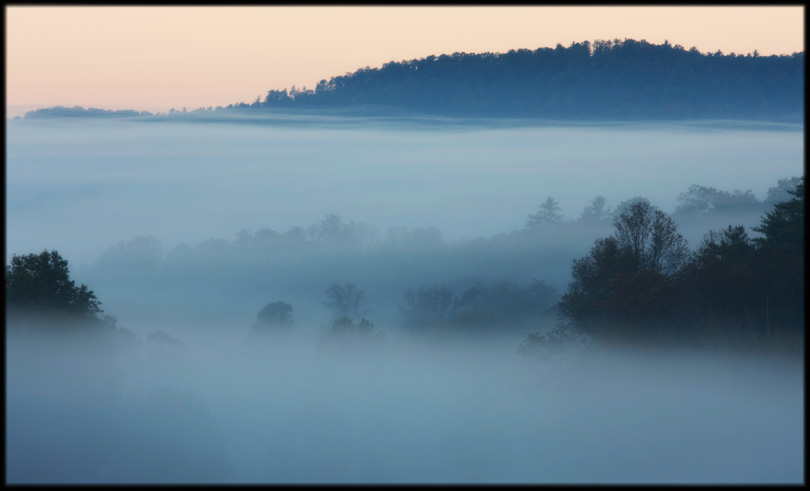
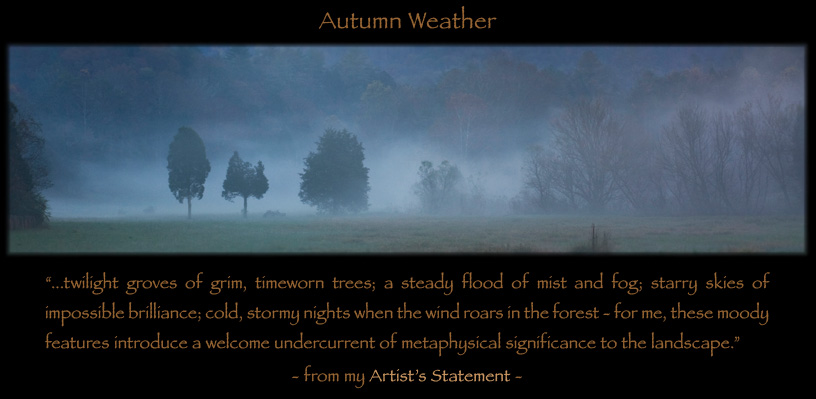
It goes without saying that the arrival of autumn's temperate climate can deliver some of the finest weather of the year - cool, sunny October days can achieve climatological perfection. But cloudy and blustery conditions typically prevail during this season, and while many are inclined to perceive a cheerless quality in such weather, I've always found an especially compelling, contemplative appeal in these gloomy days, with a chill in the air and perhaps a distant rumble of thunder announcing the approach of a storm. The drama of these conditions, when paired with the season's palette of bright color, delivers a setting that transcends mere prettiness to achieve instead a sublime and solemn beauty, charged with a sense of monumental gravity and power, from which it may seem that almost any wondrous thing might emerge - during such weather, perhaps along some solitary track through a golden, windswept forest, it might come as little surprise to encounter even a headless horseman or some other fantastic creature on a mischievous errand. In short, these are conditions of nature in which the legendary can be made to seem strangely feasible, encouraging the unrestrained travel of imaginative thought and expectation.

Fog is my favorite manifestation of seasonal weather. As a landscape artist, I find that fog works magic in a picture by producing a color harmony, by enhancing the perception of depth, and by selectively hiding and revealing the elements of a scene in compelling and ever-changing ways; this "now you see it, now you don't" aspect of the atmosphere is not only visually interesting, but wields a certain psychological power, too - fog is the very essence of mystery in the natural world, and can immediately introduce a sense of drama and intrigue to even the most mundane setting.

The netherworld of a fogbound landscape may appear as if the scene had materialized directly from the pages of Grimm's Fairy Tales; at times, the wispy, translucent forms of drifting fog can even suggest the appearance of spirits as typically conceived in traditional spooklore, contributing further to autumn's sense of otherworldly associations.
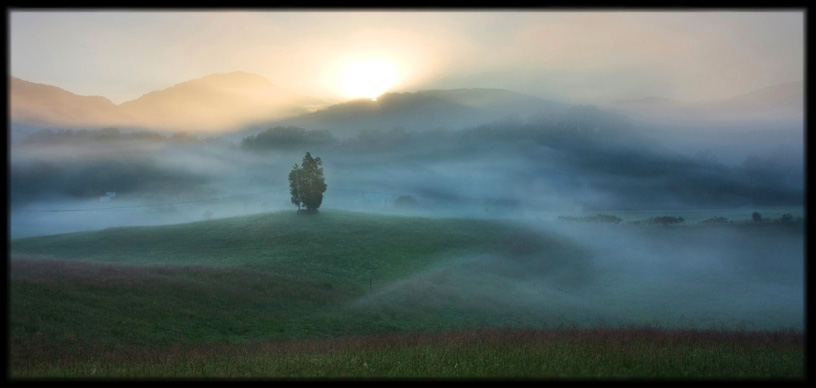
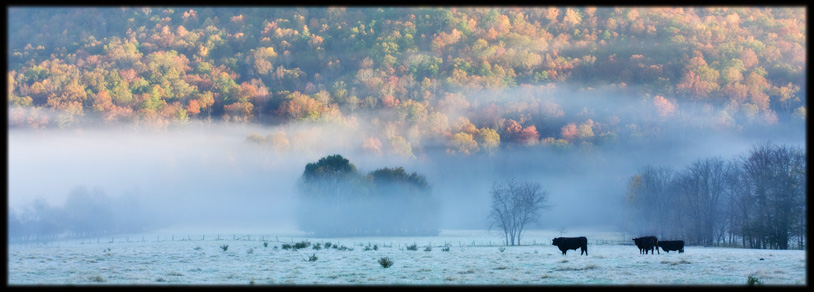
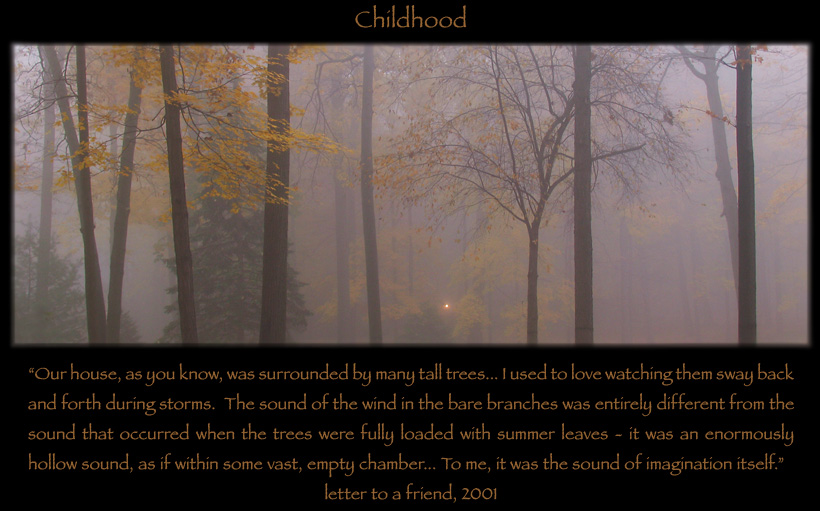
The significance of autumn in my life and work can't be fully appreciated without an introduction to the street where I grew up. Although located in a suburb of Detroit, the properties are heavily wooded with trees, which put on a breathtaking display of color during their annual transformation:
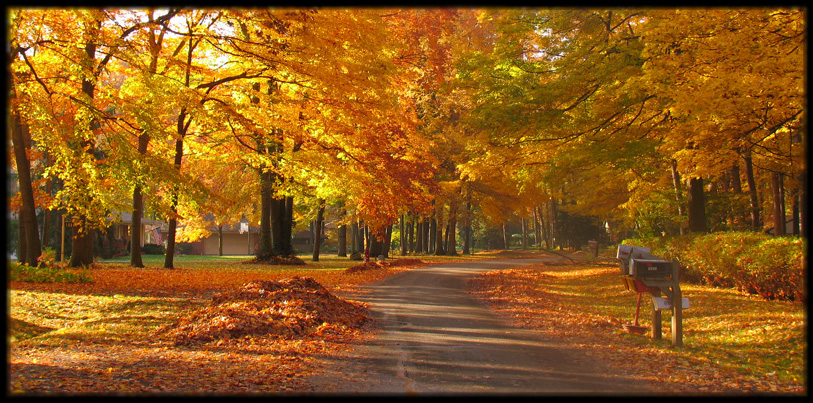
Since many of the houses are set back at some distance from the street, the area presents an atypical appearance for a suburban environment - one views the homes through a screen of trees, and approaches them by means of long driveways, and this lends a special element of mystery and beauty to what might otherwise be regarded as an unremarkable corner of suburbia:
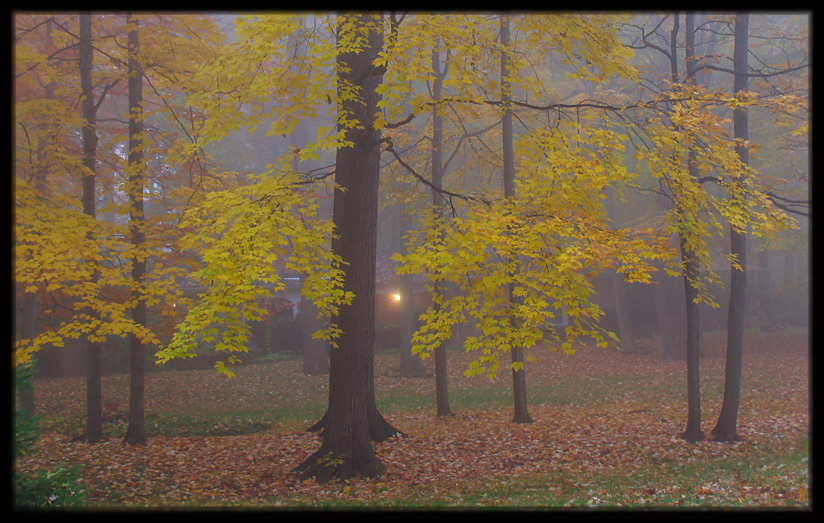
These qualities made my street a very exceptional one for trick-or-treating on Halloween, and the rare privilege of roaming this woodsy area after dark was a much-anticipated thrill. Each of these annual, twilight outings was a sort of adventure, and although I couldn't quite comprehend it at the age of eight, the thrill was always an aesthetic one: the chilly air, the starry sky, the bare tree branches, the smell of fallen leaves and chimney smoke, and the sight of warm, holiday luminaria in the form of flickering candles and jack-o-lanterns - all of this produced a setting that filled me with wonder and ultimately contributed to the formation of an aesthetic sensibility that would heavily inform my later work.
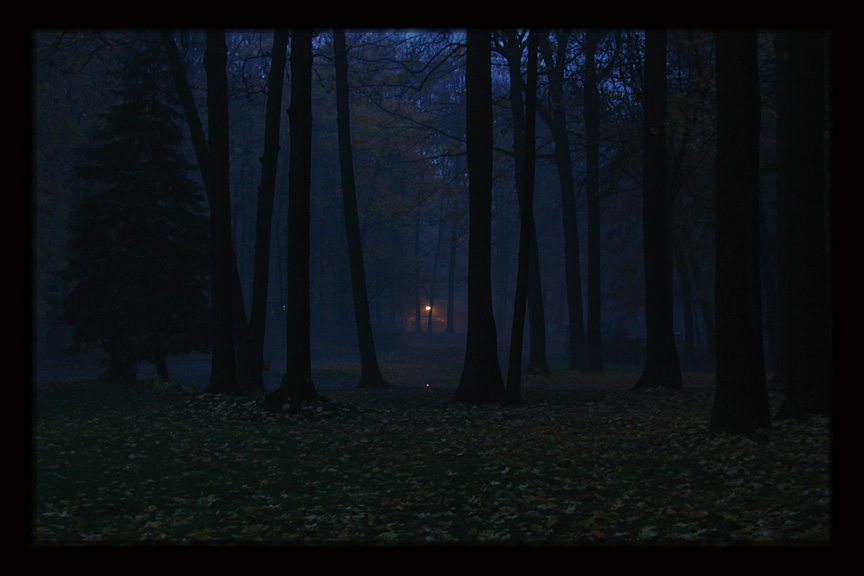
During my own twilight journeys throughout the neighborhood, I would sometimes encounter night animals such as opossums or raccoons, which were a source of great and terrible fascination for me in my childhood years; I was so afraid of these nocturnal creatures that they often found their way into nightmares, where they were inflated and transformed into much scarier monsters. It was only through years of repetitive night-terrors of this sort that I learned to take charge and dispel them through feats of defensive action on the dream stage, after which the nightmares mostly ceased to be a problem. While my real, waking life in a secure, suburban environment was devoid of notable threats or hardship, this grim, imaginative element of my own childhood psychology convinced me that perils are a necessary element of the life experience, required for the formation of character and courage, and that the mind may simply invent such obstacles if none present themselves in the external world.
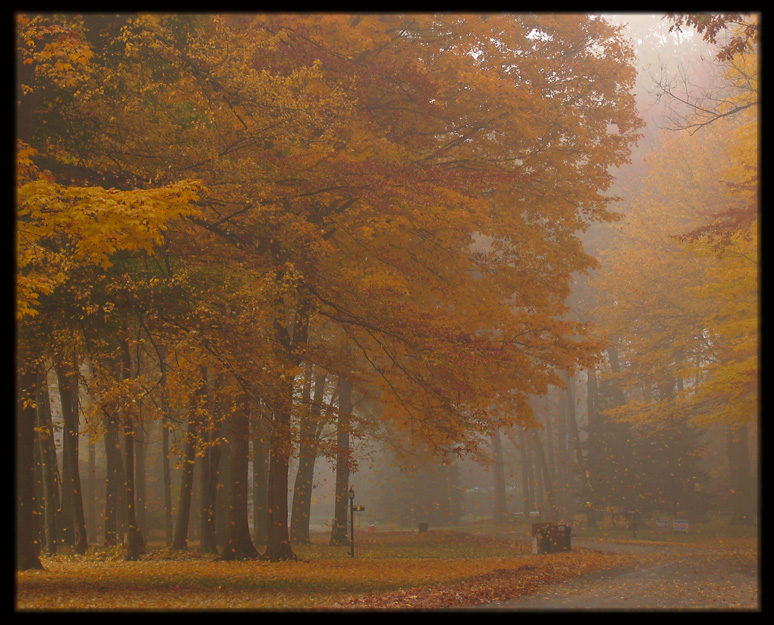
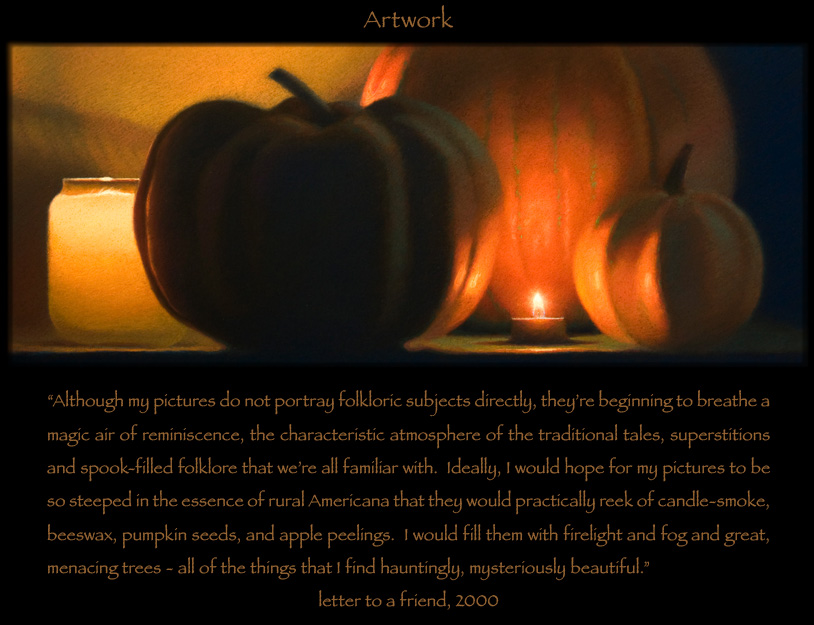
Consistent with the nature of the autumn season as I've defined it, the aesthetic ideal that I strive for in my work is characterized by an essential harmony between positive and negative elements, interwoven to complement each other in a fashion that reflects the natural distribution of these influences in everyday life. The desired result is a sense of sublime, natural grandeur that would otherwise fail in the absence of either influence.
If, in this essay, it may seem that I'm tending to emphasize the negative facet of life excessively, it's not because I deem it to be more important or interesting - rather, it's only because that facet is the one most commonly dismissed by artists in favor of an entirely benign, utopian portrayal of the world. I typically find such work to be emotionally insipid - a condition that I try to avoid above all in my own work.
This hasn't been an especially difficult task for me, since menacing elements of nature have always claimed a presence in my creative activity - note the abundance of dinosaurs and monsters to be found in my childhood artwork, for instance, and the recurring nightmares that I routinely struggled with during my early years. Although monsters in literal form have disappeared from my adult work, an overall sense of the perilous aspect of life continues to manifest itself in my paintings in a variety of ways, though always in a stable balance with the purely beautiful or wondrous elements of nature.
Let me offer a non-intuitive example of the principle that I'm describing, since the picture in question seemingly has no direct relation to autumn: my 2004 painting "Cathedral of Time" (below). The lower section of this painting depicts a severe and forbidding canyon, and the giant boulders assembled in the streambed have a monstrous quality about them - this is not only faithful to the actual place, but also serves the drama of the picture by emphasizing the brilliance and color of the optimistic, sun-filled sky far above. I could as easily have chosen a subject that seemed more readily appealing in a superficial sense, but I chose a more powerful subject - and chose to depict it faithfully - because the contrast between its positive and negative elements gave the picture more emotional depth.
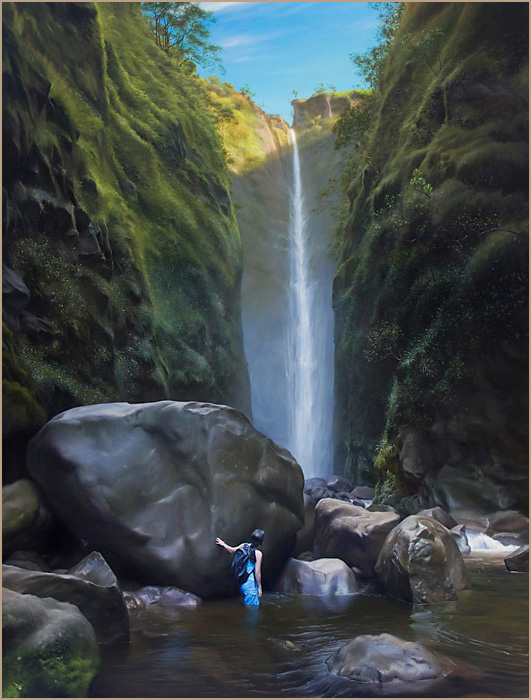
Cathedral of Time, oil on linen, 2004
Pictorial devices of this sort can be found throughout much of my portfolio of landscape work - but whether depicting locations mundane or exotic, and at any time of year, they're all connected by a common thread that ultimately leads back to the aesthetic influence of autumn days and nights on the suburban street where I grew up. In the case of the example described above, autumn's influence is seen to be a purely aesthetic or philosophical one, which can be applied abstractly to subjects of any sort, even those having nothing whatever to do with the season. But autumnal themes or subjects are also represented in my work in other ways that are much more direct or literal.
Pumpkins are outstanding objects to paint, and their relation to autumn is too obvious to require further mention; they've turned up again and again in my still-life paintings over the years:
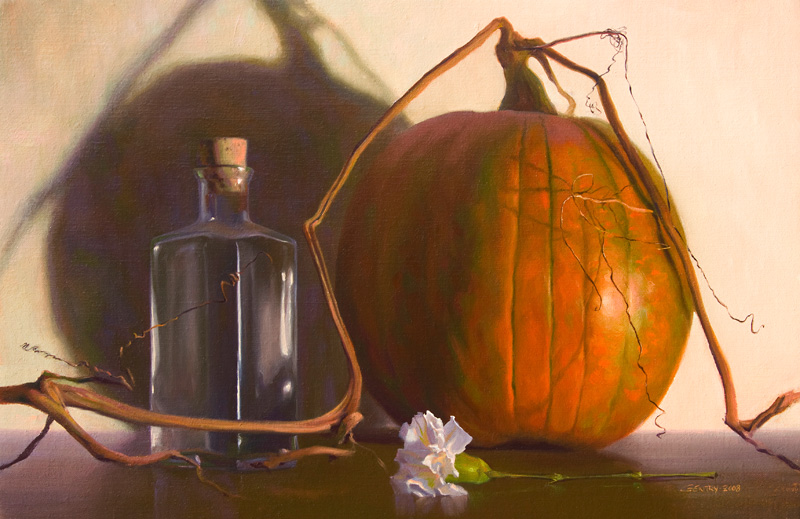
Above: Still-life with Green Pumpkin, oil on linen, 2008
Below: Candlelight, pastel on paper, 2010
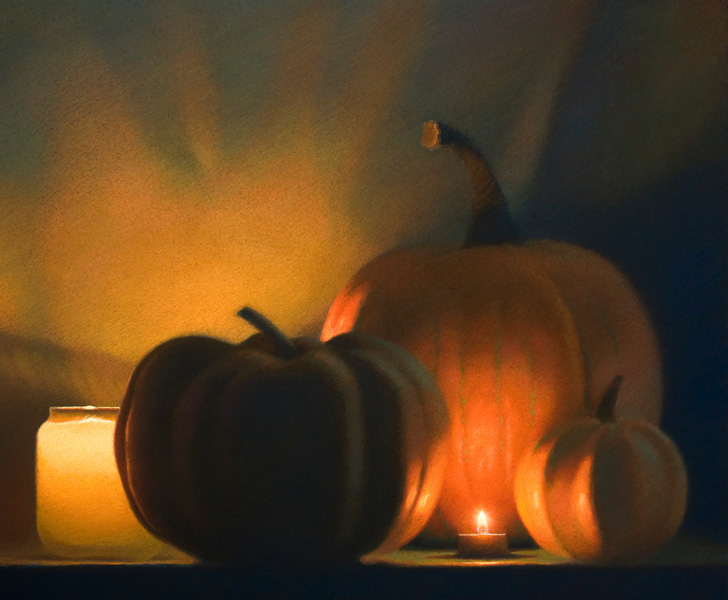
Occasionally, my landscape pictures depict autumn directly, as in this fogbound scene from my home street in Michigan:
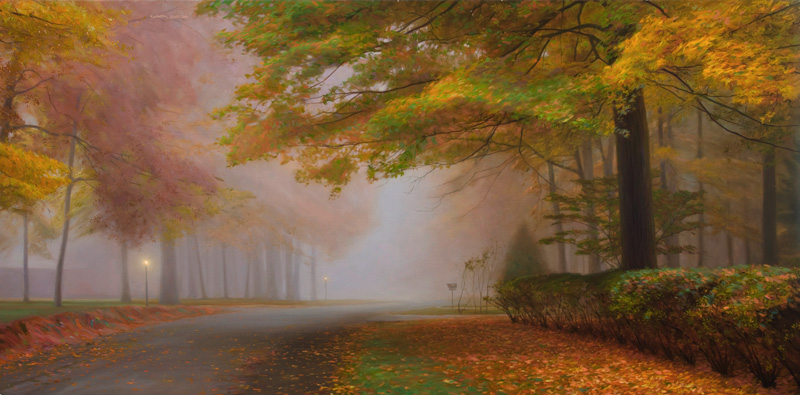
Suburban Autumn, oil on linen, 2007
But even in parts of the world where few seasonal changes occur, as in the case of my former residence on Maui, the landscape sometimes delivers warm color effects reminiscent of autumn, primarily at the moment of sunrise or sunset:
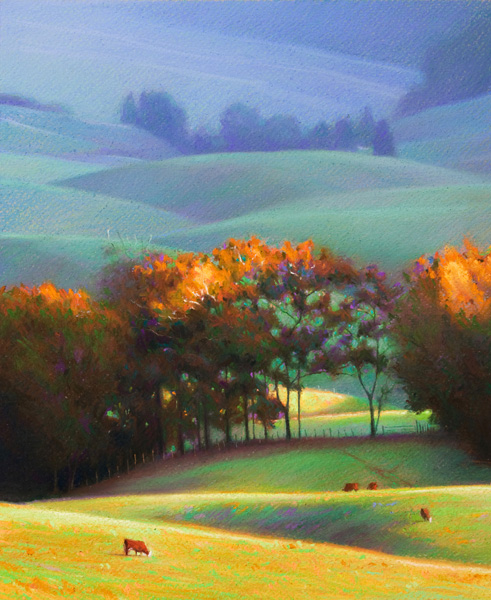
Last Light, pastel on paper, 2009
Other examples of my landscape work evoke an autumnal sensibility in a different way, by suggesting the mysterious or haunted qualities of the season. Many of my early pictures from mountainous areas of Hawaii took this approach; despite the tropical setting, they could easily be mistaken for depictions of temperate locales during the moodiness of autumn:
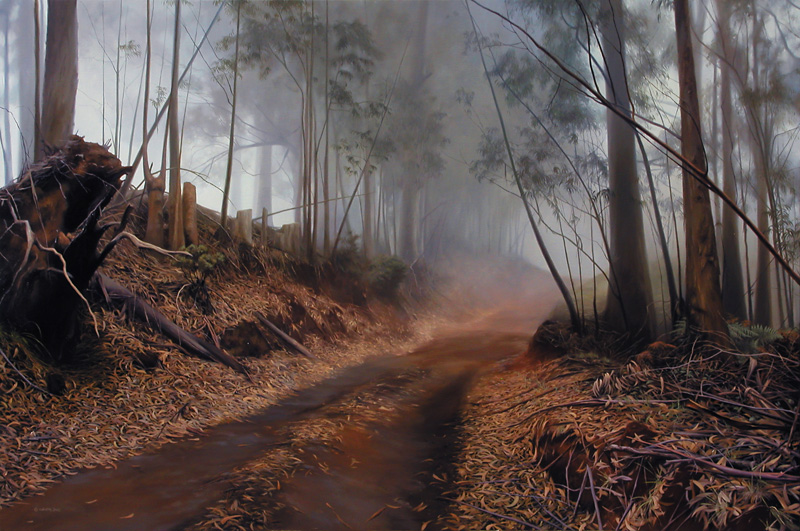
"Fog on a Mountain Road" - oil on linen, 2002
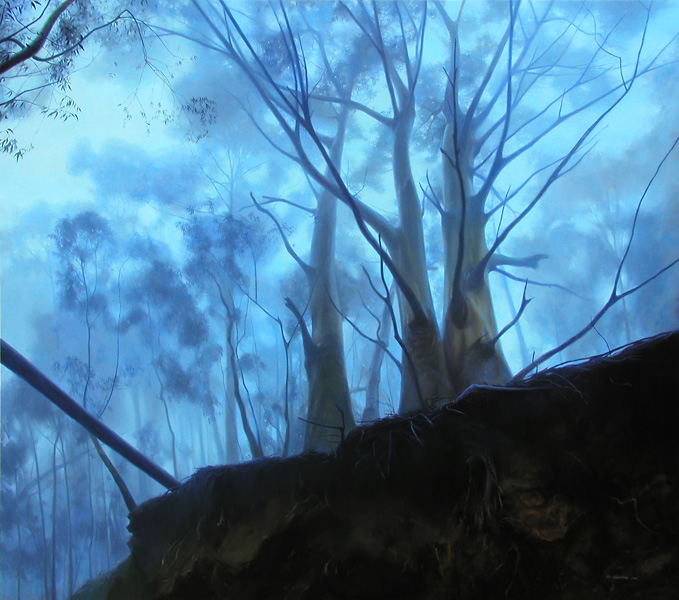
"Skyscrapers" - oil on linen, 2001
Quite an old painting now, but the pastel below is memorable for its depiction of stormy weather in the highlands of Maui, with ghostly wisps of cloud drifting below the tree-tops:
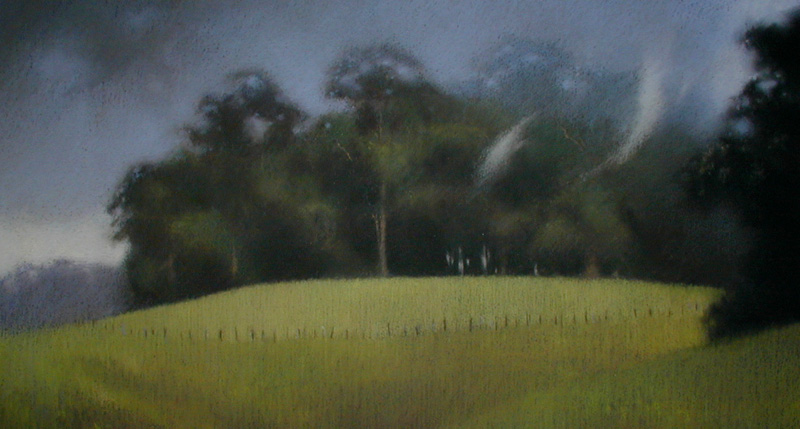
"Spirits" - pastel on paper, 2000
Other "haunted" subjects can be found in abundance throughout my work. Old, gnarled trees, for instance, appear in many of my drawings - though they typically exhibit a monstrous quality, they always have a rugged, weathered character that I find appealing and beautiful in its own way:
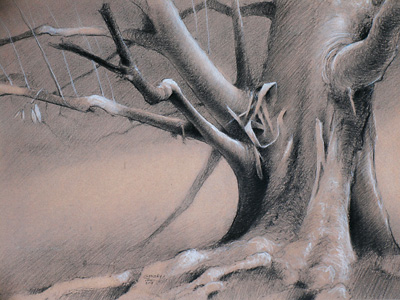
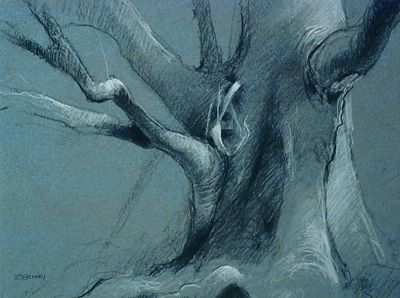
Above: Two studies of a Eucalyptus tree, Upcountry Maui, both done in 1998
Below: Forever's Tree, Upcountry Maui, 2000
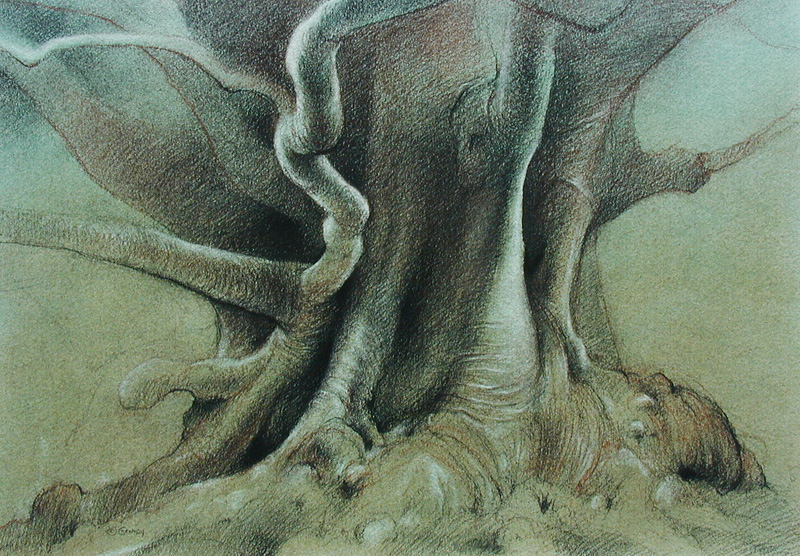
In a similar manner, night scenes have been a favorite source of inspiration for me - bursting at the seams with sentimental Halloween memories of starry skies and brightly illuminated houses, these pictures typically evoke a sense of strange enchantment and childhood wonder. An older painting from my early years on Maui was inspired by a meteor shower that I witnessed there, but could just as easily have been a dream-like memory of some October night:
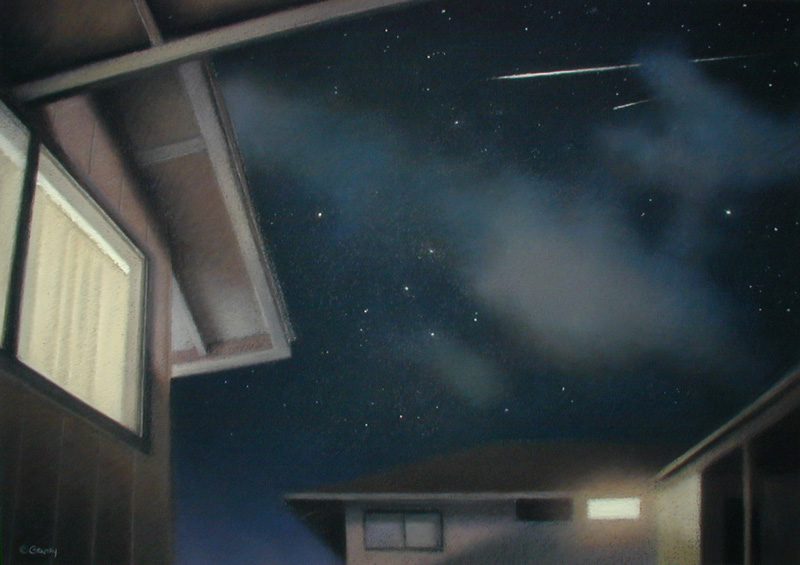
Meteor Shower, pastel on paper, 2000
Other work from that period reveals the same fascination for the night sky and the appearance of homes as seen after dark, warmly lit from within:
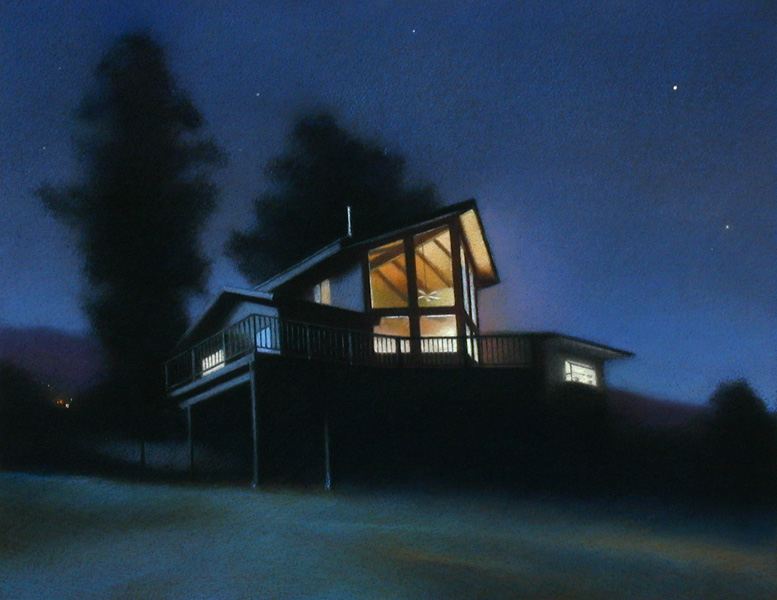
Mountain Home, pastel on paper, 2000